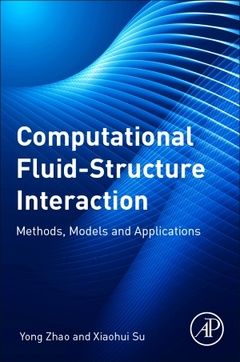Description
Computational Fluid-Structure Interaction
Methods, Models, and Applications
Authors: Zhao Yong, Su Xiaohui
Language: English
Subject for Computational Fluid-Structure Interaction:
Keywords
ALE; Aeroelastic flutter; Arbitrary Lagrangian-Eulerian (ALE); Artificial compressibility method; CSD; Characteristics-based methods; Collapsible channel; Compressible viscous flow; Cylinder; Deformable wing; Domain decomposition; Dual-time-stepping method; Elastic deformation; Energy consumption; Eulerian grid; FSI; Flexible membrane; Fluid-structure interaction; Ghost node; Heart valves; IOM; Immersed membrane method; Immersed object method; Implicit scheme; Incompressible viscous flow; Interconnectivity; Lagrangian grid; Lid-driven cavity; Lid-driven flow; Lift force generation mechanism; MAV; Matrix-free method; Mesh movement; Moving circular disk; Moving rigid body; Multigrid; Multigrid (MG); Multigrid method; Navier-Stokes equations; Oscillating circular cylinder; Overlapping grids; Overlapping grids (OGs); Parallel; Parallel computation; Parallel strategy; Parallelization method; Preconditioning; Rigid wing; Runge-Kutta time integration; Sharp fluid-structure interface; Single grid (SG); Single program multiple data; Structural dynamic equations; Structural dynamics; Unsteady flow; Unstructured grid; Viscous compressible flow; Viscous incompressible flow; Zoning of the calculation domain
504 p. · 15x22.8 cm · Paperback
Description
/li>Contents
/li>Readership
/li>Biography
/li>Comment
/li>
Computational Fluid-Structure Interaction: Methods, Models, and Applications provides detailed explanations of a range of FSI models, their mathematical formulations, validations, and applications, with an emphasis on conservative unstructured-grid FVM. The first part of the book presents the nascent numerical methods, algorithms and solvers for both compressible and incompressible flows, computational structural dynamics (CSD), parallel multigrid, IOM, IMM and ALE methods. The second half covers the validations of these numerical methods and solvers, as well as their applications in a broad range of areas in basic research and engineering.
1. Introduction2. Mathematical Formulation for Preconditioned Compressible Flow Solver3. Mathematical Formulation for Incompressible Flow Solver 4. Mathematical Formulation for Computational Structural Dynamics 5. The Multigrid Method 6. Parallel Computation 7. The Immersed Object Method with Overlapping Grids8. Immersed Membrane Method and Fluid-Structure Interaction 9. Arbitrary Lagrangian Eulerian Method and Fluid Structure Interaction10. IMM FSI Model Validations and Applications 11. IMM FSI Model Validations and Applications for Incompressible Flows12. IMM FSI Model Validations and Applications for Compressible Flow
Researchers and postgraduate students with backgrounds in mechanical engineering, civil engineering, or biomedical engineering working on projects involving fluid structure interaction. Practicing CFD and FEA engineers and consultants.
Xiaohui Su is a Professor of Hydraulic Engineering at Dalian University of Technology and a member of Chinese Hydraulic Engineering Society in China. He was a key member of Professor Yong Zhao’s research group during his tenure as a postdoctoral research fellow at Nanyang Technological University in Singapore. He has worked as a research fellow at Tropical Marine Science Institute in Singapore, a hydraulics engineer in DHI-NTU Water and Environment Research Centre and Education Hub in Singapore, and also a research consultant in Atlantis Resources Cooperation Pte Ltd. He has published over 40 papers in CFD and his current research focuses on the design of bionics flapping aircraft using FSI modelling.
- Provides a comprehensive overview of the latest numerical methods used in FSI, including the unstructured-grid finite volume method (FVM), parallel multigrid scheme, overlapping mesh, immersed object method (IOM), immersed membrane method (IMM), arbitrary Lagragian-Eulerian (ALE), and more
- Provides full details of the numerical methods, solvers and their validations
- Compares different methods to help readers more effectively choose the right approach for their own FSI problems
- Features real-life FSI case studies, such as large eddy simulation of aeroelastic flutter of a wing, parallel computation of a bio-prosthetic heart valve, and ALE study of a micro aerial vehicle
These books may interest you

Computational Fluid Dynamics 89.57 €

Fluid-Solid Interaction DynamicsTheory, Variational Principles, Numerical Methods, and Applications 334.71 €

Computational Fluid Dynamics 74.82 €

